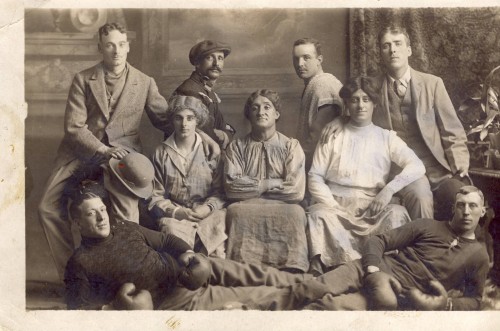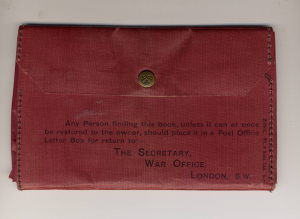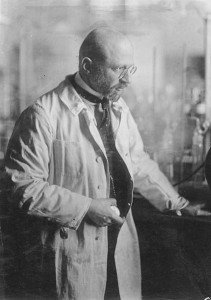 According to his discharge papers, he stood five feet, eight inches tall. He had a pale complexion, brown hair, blue eyes, two moles on his back, his sole distinguishing marks. In June 1918, he was discharged from the British Army with a disability received in the Great War–a sadly innocent term that people used before they became accustomed to slaughter on an industrial level.
According to his discharge papers, he stood five feet, eight inches tall. He had a pale complexion, brown hair, blue eyes, two moles on his back, his sole distinguishing marks. In June 1918, he was discharged from the British Army with a disability received in the Great War–a sadly innocent term that people used before they became accustomed to slaughter on an industrial level.
I barely knew my grandfather, James Cooney. He was a distant man who spent much of his time in his room reading, as I recall. I don’t know exactly when he became so distant and remote, but I am pretty certain that it began in the Great War, most likely on a spring day in 1915, when he discovered for himself the brilliance of a renowned German scientist, Fritz Haber.
 I first started to piece together my grandfather’s story nearly two decades ago, and over the years, I have accumulated some of his documents and photographs, things my mother put away, and that I eventually inherited. In a small red folding wallet issued by the War Office in London, for example, I found his military papers, inscribed on onion paper so thin and friable that I felt as if I was handling the Dead Sea scrolls.
I first started to piece together my grandfather’s story nearly two decades ago, and over the years, I have accumulated some of his documents and photographs, things my mother put away, and that I eventually inherited. In a small red folding wallet issued by the War Office in London, for example, I found his military papers, inscribed on onion paper so thin and friable that I felt as if I was handling the Dead Sea scrolls.
On August 4, 1914, the day that Britain declared war on Germany, my grandfather was working in a remote corner of the empire, the little windswept prairie town of Fort Macleod, Alberta. The sabre-rattling in Europe must have seemed a world away, but he soon realized that he and his family—a wife and three young children—would be asked to pay a price. Born and raised in Greenwich, England, my grandfather had enlisted as a young man in the British Army, and after completing his term of service, he was automatically transferred into the Reserve. When his queen and country called in 1914, my grandfather was forced to return to England. There he was assigned to the Royal Garrison Artillery and dispatched to the Western Front.
And for a short time, perhaps, things may not have been too bad. In a stack of old photos, I found a picture of my grandfather looking relaxed and amused as he posed for the camera with a group of fellow soldiers, some kitted out as women. On the back, my mother and her brother had jotted down a note: “Dad, Top Row, right. This was a play by soldiers in 1914-18 war.” With little professional entertainment around, World War I troops frequently amused themselves with music-hall skits.
But what fun there was ended in the spring of 1915. According to family stories, my grandfather was sent to the front lines in Belgium, to a town called Ypres. It was exactly the wrong place to be. The renowned German chemist Fritz Haber, who discovered how to fix nitrogen from air—a key step in manufacturing agricultural fertilizers and explosives—had turned his attention to chemical weaponry. Although French researchers had experimented with tear-gas grenades, Haber envisioned a much deadlier weapon: clouds of chlorine gas. In April 1915, he was ready to try it out at Ypres.
 Haber journeyed to front the lines personally to oversee the operation. On April 22, under his directions, the German army waited for the wind to turn toward the Allied lines. Finally, around five pm, a strong breeze began blowing in the right direction. Signalled by their officers, German troops opened 5730 cylinders of chlorine gas. It was enough to create a rolling wall of eerie green gas that flowed directly toward French and Algerian troops. In just ten terrible minutes, some 5000 men asphyxiated.
Haber journeyed to front the lines personally to oversee the operation. On April 22, under his directions, the German army waited for the wind to turn toward the Allied lines. Finally, around five pm, a strong breeze began blowing in the right direction. Signalled by their officers, German troops opened 5730 cylinders of chlorine gas. It was enough to create a rolling wall of eerie green gas that flowed directly toward French and Algerian troops. In just ten terrible minutes, some 5000 men asphyxiated.
In the weeks that followed, the German army unleashed this terrifying weapon repeatedly. As one British soldier, Lieutenant V.F.S. Hawkins, later recalled, he and his colleagues felt nearly powerless to defend themselves. “Men were going down all about and struggling for air as if they were drowning, at the bottom of our so-called trench.”
According to family lore, my grandfather was caught in one of those deadly attacks. He survived, however, and spent the next year in a convalescent hospital. When he was deemed strong enough, he returned to duty as a trainman behind the lines. On the back of his discharge papers in 1918, his commanding officer wrote that he was “a man of exemplary character.” But my grandfather was never quite the same after the war. When he returned to Fort Macleod in 1918, he looked much older than his 32 years: his hair had turned almost completely grey and his health was frail.
That same year, 1918, Fritz Haber won the Nobel Prize for chemistry for his work on the fixation of nitrogen from the air. To its shame, the Nobel Foundation makes only a fleeting reference on its website to Haber’s leadership in the development of chemical warfare.
Photos: James Cooney and fellow soldiers in First World War, author’s collection ; red wallet, author’s collection; Fritz Haber, photo from German Federal Archives.